MATH1 Assignment: Detailed Solutions for Mathematical Problems
VerifiedAdded on 2022/08/29
|7
|991
|27
Homework Assignment
AI Summary
This document presents solutions to a MATH1 assignment focusing on fundamental concepts in mathematics, including linear algebra and geometry. The solutions cover several problems, such as proving properties of scalar products in Euclidean spaces, parameterizing points on unit spheres, demonstrating isomorphisms between vector spaces and Rn, and analyzing properties of orthogonal matrices and antisymmetric matrices. The assignment also explores the concept of inner product spaces and their relation to matrix representations. The document provides detailed proofs and explanations for each problem, offering a comprehensive resource for students studying these mathematical topics. The content is well-structured, providing a clear understanding of the concepts and methodologies involved in solving the mathematical problems.

MATH1
MATH
by Student’s Name
Code + Course Name
Professor’s Name
University Name
City, State
Date
MATH
by Student’s Name
Code + Course Name
Professor’s Name
University Name
City, State
Date
Paraphrase This Document
Need a fresh take? Get an instant paraphrase of this document with our AI Paraphraser
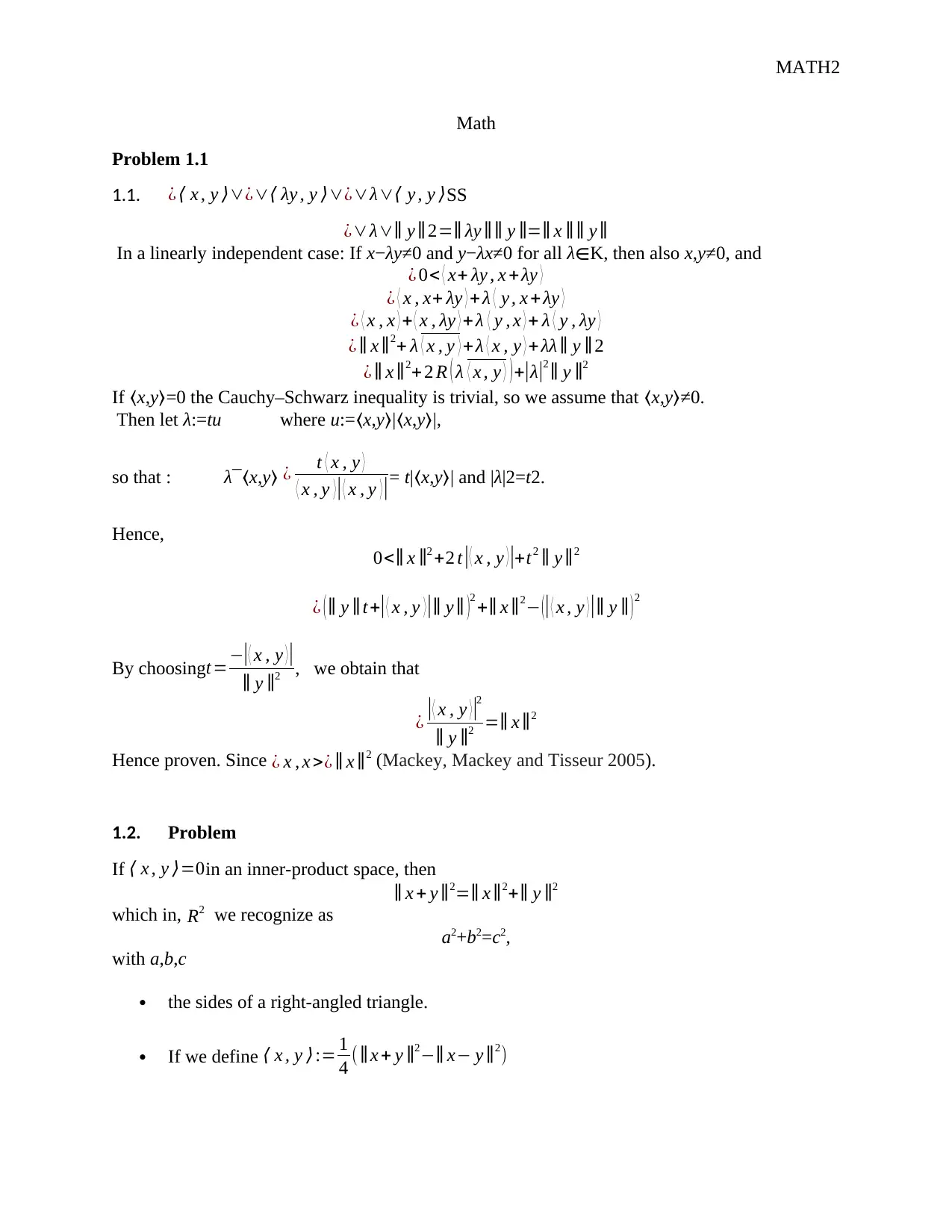
MATH2
Math
Problem 1.1
1.1. ¿ ⟨ x , y ⟩∨¿∨⟨ λy , y ⟩∨¿∨λ∨⟨ y , y ⟩SS
¿∨λ∨∥ y ∥ 2=∥ λy ∥∥ y ∥=∥ x ∥∥ y ∥
In a linearly independent case: If x−λy≠0 and y−λx≠0 for all λ∈K, then also x,y≠0, and
¿ 0< ⟨ x+ λy , x + λy ⟩
¿ ⟨ x , x+ λy ⟩ + λ ⟨ y , x + λy ⟩
¿ ⟨ x , x ⟩ + ⟨ x , λy ⟩ + λ ⟨ y , x ⟩ + λ ⟨ y , λy ⟩
¿ ∥ x ∥2+ λ ⟨ x , y ⟩ +λ ⟨ x , y ⟩ + λλ ∥ y ∥ 2
¿ ∥ x ∥2+ 2 R ( λ ⟨ x , y ⟩ ) +|λ|
2 ∥ y ∥2
If ⟨x,y⟩=0 the Cauchy–Schwarz inequality is trivial, so we assume that ⟨x,y⟩≠0.
Then let λ:=tu where u:=⟨x,y⟩|⟨x,y⟩|,
so that : λ¯⟨x,y⟩ ¿ t ⟨ x , y ⟩
⟨ x , y ⟩|⟨ x , y ⟩|= t|⟨x,y⟩| and |λ|2=t2.
Hence,
0<∥ x ∥2 +2 t |⟨ x , y ⟩|+t2 ∥ y ∥2
¿ (∥ y ∥t+|⟨ x , y ⟩|∥ y ∥ )2
+∥ x ∥2− (|⟨ x , y ⟩|∥ y ∥ )2
By choosingt=−|⟨ x , y ⟩|
∥ y ∥2 , we obtain that
¿ |⟨ x , y ⟩|2
∥ y ∥2 =∥ x ∥2
Hence proven. Since ¿ x , x >¿ ∥ x ∥2 (Mackey, Mackey and Tisseur 2005).
1.2. Problem
If ⟨ x , y ⟩=0in an inner-product space, then
∥ x + y ∥2=∥ x ∥2+∥ y ∥2
which in, R2 we recognize as
a2+b2=c2,
with a,b,c
the sides of a right-angled triangle.
If we define ⟨ x , y ⟩ := 1
4 ( ∥x + y ∥2−∥ x− y ∥2)
Math
Problem 1.1
1.1. ¿ ⟨ x , y ⟩∨¿∨⟨ λy , y ⟩∨¿∨λ∨⟨ y , y ⟩SS
¿∨λ∨∥ y ∥ 2=∥ λy ∥∥ y ∥=∥ x ∥∥ y ∥
In a linearly independent case: If x−λy≠0 and y−λx≠0 for all λ∈K, then also x,y≠0, and
¿ 0< ⟨ x+ λy , x + λy ⟩
¿ ⟨ x , x+ λy ⟩ + λ ⟨ y , x + λy ⟩
¿ ⟨ x , x ⟩ + ⟨ x , λy ⟩ + λ ⟨ y , x ⟩ + λ ⟨ y , λy ⟩
¿ ∥ x ∥2+ λ ⟨ x , y ⟩ +λ ⟨ x , y ⟩ + λλ ∥ y ∥ 2
¿ ∥ x ∥2+ 2 R ( λ ⟨ x , y ⟩ ) +|λ|
2 ∥ y ∥2
If ⟨x,y⟩=0 the Cauchy–Schwarz inequality is trivial, so we assume that ⟨x,y⟩≠0.
Then let λ:=tu where u:=⟨x,y⟩|⟨x,y⟩|,
so that : λ¯⟨x,y⟩ ¿ t ⟨ x , y ⟩
⟨ x , y ⟩|⟨ x , y ⟩|= t|⟨x,y⟩| and |λ|2=t2.
Hence,
0<∥ x ∥2 +2 t |⟨ x , y ⟩|+t2 ∥ y ∥2
¿ (∥ y ∥t+|⟨ x , y ⟩|∥ y ∥ )2
+∥ x ∥2− (|⟨ x , y ⟩|∥ y ∥ )2
By choosingt=−|⟨ x , y ⟩|
∥ y ∥2 , we obtain that
¿ |⟨ x , y ⟩|2
∥ y ∥2 =∥ x ∥2
Hence proven. Since ¿ x , x >¿ ∥ x ∥2 (Mackey, Mackey and Tisseur 2005).
1.2. Problem
If ⟨ x , y ⟩=0in an inner-product space, then
∥ x + y ∥2=∥ x ∥2+∥ y ∥2
which in, R2 we recognize as
a2+b2=c2,
with a,b,c
the sides of a right-angled triangle.
If we define ⟨ x , y ⟩ := 1
4 ( ∥x + y ∥2−∥ x− y ∥2)
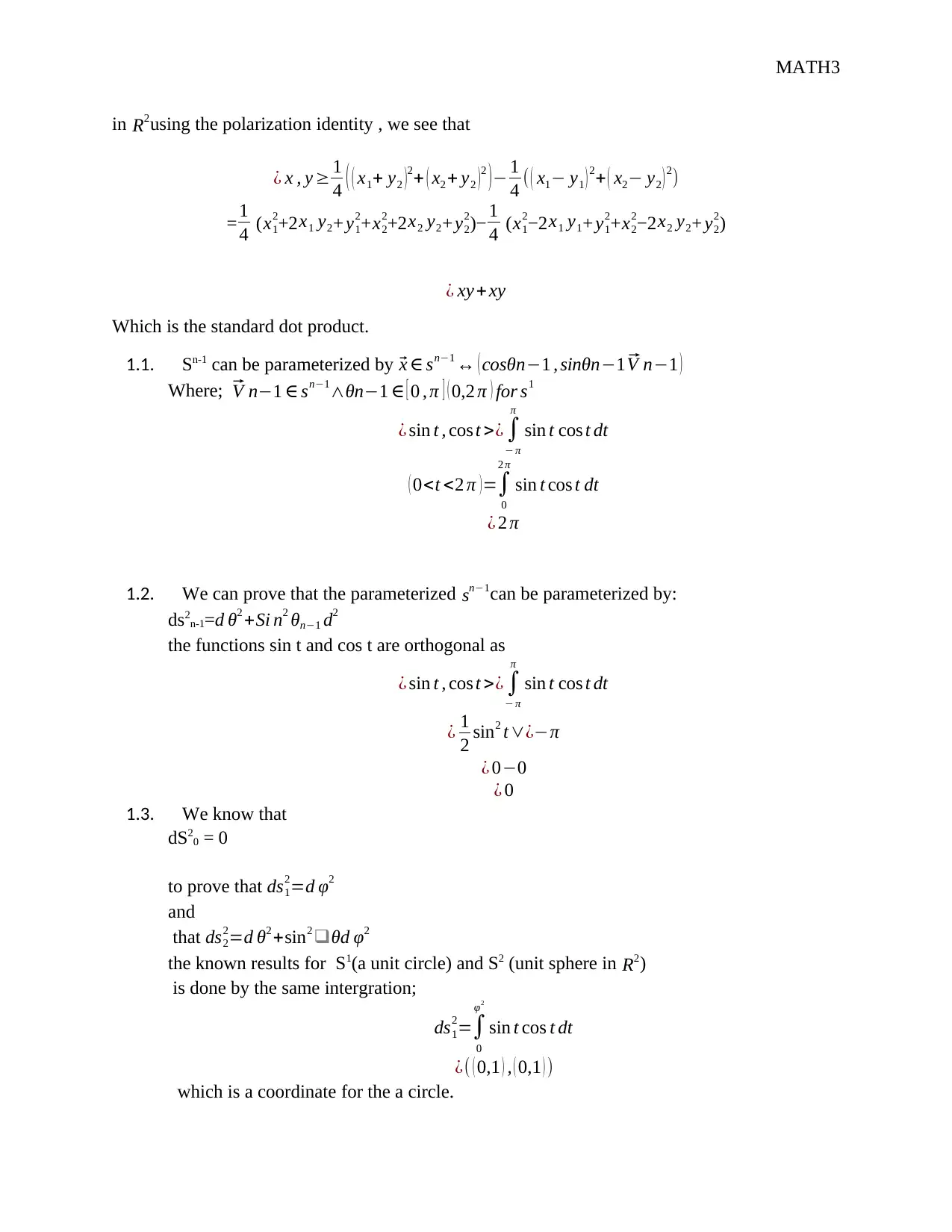
MATH3
in R2using the polarization identity , we see that
¿ x , y ≥ 1
4 ( ( x1+ y2 )2+ ( x2 + y2 )2
)− 1
4 ( ( x1− y1 ) 2+ ( x2− y2 )2)
= 1
4 ( x1
2+2x1 y2+ y1
2+ x2
2+2x2 y2+ y2
2)− 1
4 ( x1
2−2x1 y1+ y1
2+ x2
2−2 x2 y2+ y2
2)
¿ xy + xy
Which is the standard dot product.
1.1. Sn-1 can be parameterized by ⃗ x ∈ sn−1 ↔ ( cosθn−1 , sinθn−1⃗ V n−1 )
Where;⃗ V n−1 ∈ sn−1∧θn−1 ∈ [ 0 , π ] ( 0,2 π ) for s1
¿ sin t , cos t >¿ ∫
− π
π
sin t cos t dt
( 0<t <2 π ) =∫
0
2 π
sin t cos t dt
¿ 2 π
1.2. We can prove that the parameterized sn−1can be parameterized by:
ds2n-1=d θ2 +Si n2 θn−1 d2
the functions sin t and cos t are orthogonal as
¿ sin t , cos t >¿ ∫
− π
π
sin t cos t dt
¿ 1
2 sin2 t∨¿−π
¿ 0−0
¿ 0
1.3. We know that
dS20 = 0
to prove that ds1
2=d φ2
and
that ds2
2=d θ2 +sin2 ❑θd φ2
the known results for S1(a unit circle) and S2 (unit sphere in R2)
is done by the same intergration;
ds1
2=∫
0
φ2
sin t cos t dt
¿( ( 0,1 ) , ( 0,1 ) )
which is a coordinate for the a circle.
in R2using the polarization identity , we see that
¿ x , y ≥ 1
4 ( ( x1+ y2 )2+ ( x2 + y2 )2
)− 1
4 ( ( x1− y1 ) 2+ ( x2− y2 )2)
= 1
4 ( x1
2+2x1 y2+ y1
2+ x2
2+2x2 y2+ y2
2)− 1
4 ( x1
2−2x1 y1+ y1
2+ x2
2−2 x2 y2+ y2
2)
¿ xy + xy
Which is the standard dot product.
1.1. Sn-1 can be parameterized by ⃗ x ∈ sn−1 ↔ ( cosθn−1 , sinθn−1⃗ V n−1 )
Where;⃗ V n−1 ∈ sn−1∧θn−1 ∈ [ 0 , π ] ( 0,2 π ) for s1
¿ sin t , cos t >¿ ∫
− π
π
sin t cos t dt
( 0<t <2 π ) =∫
0
2 π
sin t cos t dt
¿ 2 π
1.2. We can prove that the parameterized sn−1can be parameterized by:
ds2n-1=d θ2 +Si n2 θn−1 d2
the functions sin t and cos t are orthogonal as
¿ sin t , cos t >¿ ∫
− π
π
sin t cos t dt
¿ 1
2 sin2 t∨¿−π
¿ 0−0
¿ 0
1.3. We know that
dS20 = 0
to prove that ds1
2=d φ2
and
that ds2
2=d θ2 +sin2 ❑θd φ2
the known results for S1(a unit circle) and S2 (unit sphere in R2)
is done by the same intergration;
ds1
2=∫
0
φ2
sin t cos t dt
¿( ( 0,1 ) , ( 0,1 ) )
which is a coordinate for the a circle.
⊘ This is a preview!⊘
Do you want full access?
Subscribe today to unlock all pages.

Trusted by 1+ million students worldwide
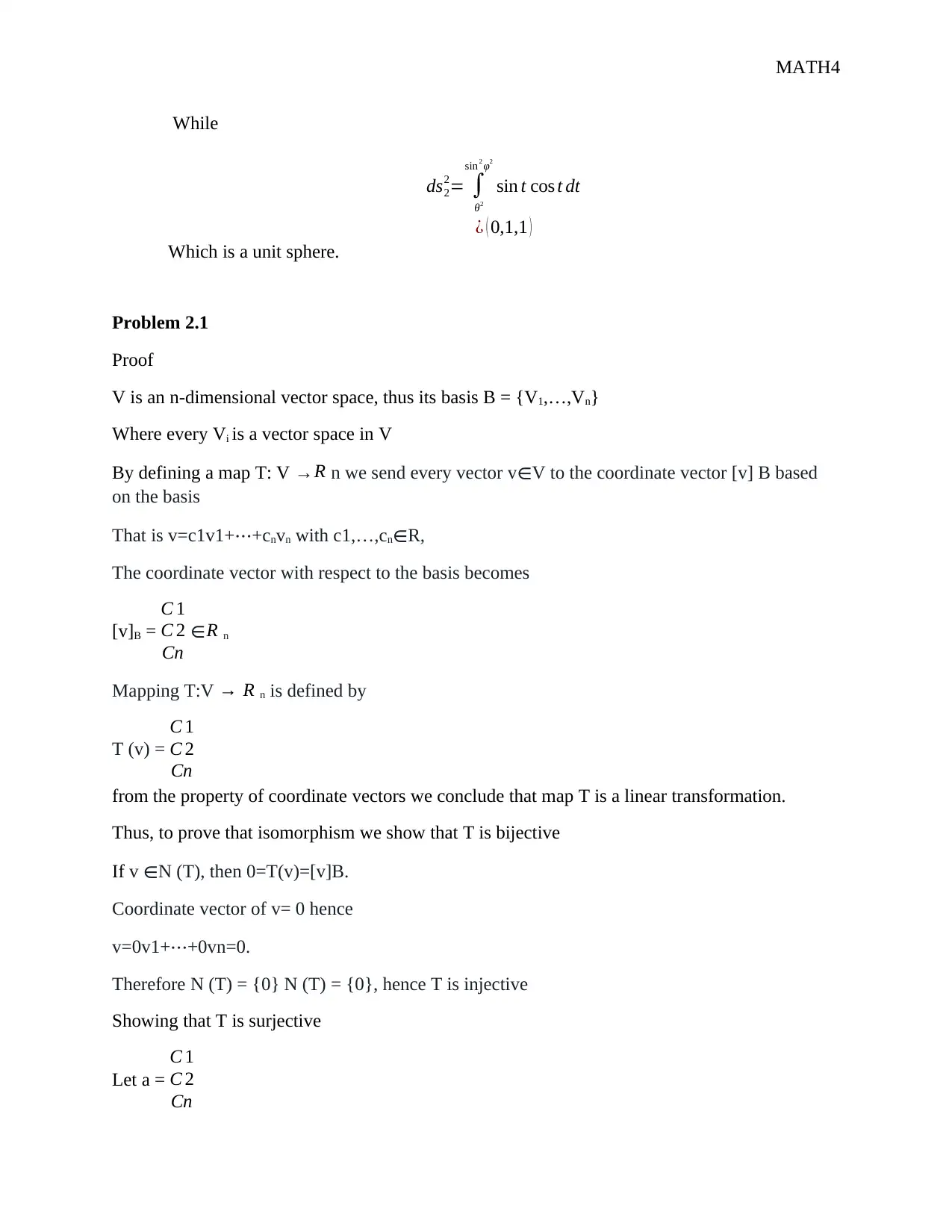
MATH4
While
ds2
2= ∫
θ2
sin2 φ2
sin t cos t dt
¿ ( 0,1,1 )
Which is a unit sphere.
Problem 2.1
Proof
V is an n-dimensional vector space, thus its basis B = {V1,…,Vn}
Where every Vi is a vector space in V
By defining a map T: V →R n we send every vector v∈V to the coordinate vector [v] B based
on the basis
That is v=c1v1+⋯+cnvn with c1,…,cn∈R,
The coordinate vector with respect to the basis becomes
[v]B =
C 1
C 2
Cn
∈ R n
Mapping T:V → R n is defined by
T (v) =
C 1
C 2
Cn
from the property of coordinate vectors we conclude that map T is a linear transformation.
Thus, to prove that isomorphism we show that T is bijective
If v ∈N (T), then 0=T(v)=[v]B.
Coordinate vector of v= 0 hence
v=0v1+⋯+0vn=0.
Therefore N (T) = {0} N (T) = {0}, hence T is injective
Showing that T is surjective
Let a =
C 1
C 2
Cn
While
ds2
2= ∫
θ2
sin2 φ2
sin t cos t dt
¿ ( 0,1,1 )
Which is a unit sphere.
Problem 2.1
Proof
V is an n-dimensional vector space, thus its basis B = {V1,…,Vn}
Where every Vi is a vector space in V
By defining a map T: V →R n we send every vector v∈V to the coordinate vector [v] B based
on the basis
That is v=c1v1+⋯+cnvn with c1,…,cn∈R,
The coordinate vector with respect to the basis becomes
[v]B =
C 1
C 2
Cn
∈ R n
Mapping T:V → R n is defined by
T (v) =
C 1
C 2
Cn
from the property of coordinate vectors we conclude that map T is a linear transformation.
Thus, to prove that isomorphism we show that T is bijective
If v ∈N (T), then 0=T(v)=[v]B.
Coordinate vector of v= 0 hence
v=0v1+⋯+0vn=0.
Therefore N (T) = {0} N (T) = {0}, hence T is injective
Showing that T is surjective
Let a =
C 1
C 2
Cn
Paraphrase This Document
Need a fresh take? Get an instant paraphrase of this document with our AI Paraphraser
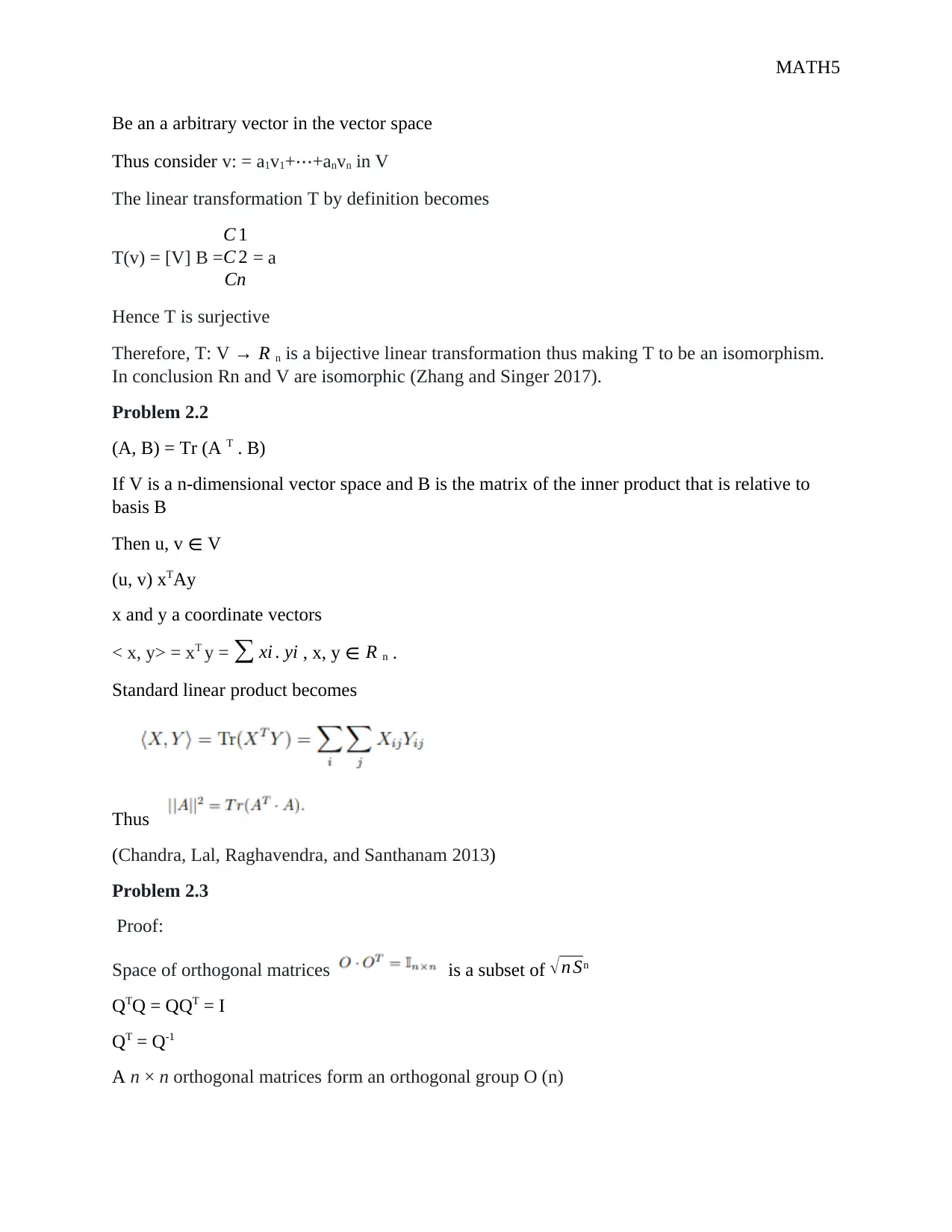
MATH5
Be an a arbitrary vector in the vector space
Thus consider v: = a1v1+⋯+anvn in V
The linear transformation T by definition becomes
T(v) = [V] B =
C 1
C 2
Cn
= a
Hence T is surjective
Therefore, T: V → R n is a bijective linear transformation thus making T to be an isomorphism.
In conclusion Rn and V are isomorphic (Zhang and Singer 2017).
Problem 2.2
(A, B) = Tr (A T . B)
If V is a n-dimensional vector space and B is the matrix of the inner product that is relative to
basis B
Then u, v ∈ V
(u, v) xTAy
x and y a coordinate vectors
< x, y> = xT y = ∑ xi . yi , x, y ∈ R n .
Standard linear product becomes
Thus
(Chandra, Lal, Raghavendra, and Santhanam 2013)
Problem 2.3
Proof:
Space of orthogonal matrices is a subset of √n Sn
QTQ = QQT = I
QT = Q-1
A n × n orthogonal matrices form an orthogonal group O (n)
Be an a arbitrary vector in the vector space
Thus consider v: = a1v1+⋯+anvn in V
The linear transformation T by definition becomes
T(v) = [V] B =
C 1
C 2
Cn
= a
Hence T is surjective
Therefore, T: V → R n is a bijective linear transformation thus making T to be an isomorphism.
In conclusion Rn and V are isomorphic (Zhang and Singer 2017).
Problem 2.2
(A, B) = Tr (A T . B)
If V is a n-dimensional vector space and B is the matrix of the inner product that is relative to
basis B
Then u, v ∈ V
(u, v) xTAy
x and y a coordinate vectors
< x, y> = xT y = ∑ xi . yi , x, y ∈ R n .
Standard linear product becomes
Thus
(Chandra, Lal, Raghavendra, and Santhanam 2013)
Problem 2.3
Proof:
Space of orthogonal matrices is a subset of √n Sn
QTQ = QQT = I
QT = Q-1
A n × n orthogonal matrices form an orthogonal group O (n)
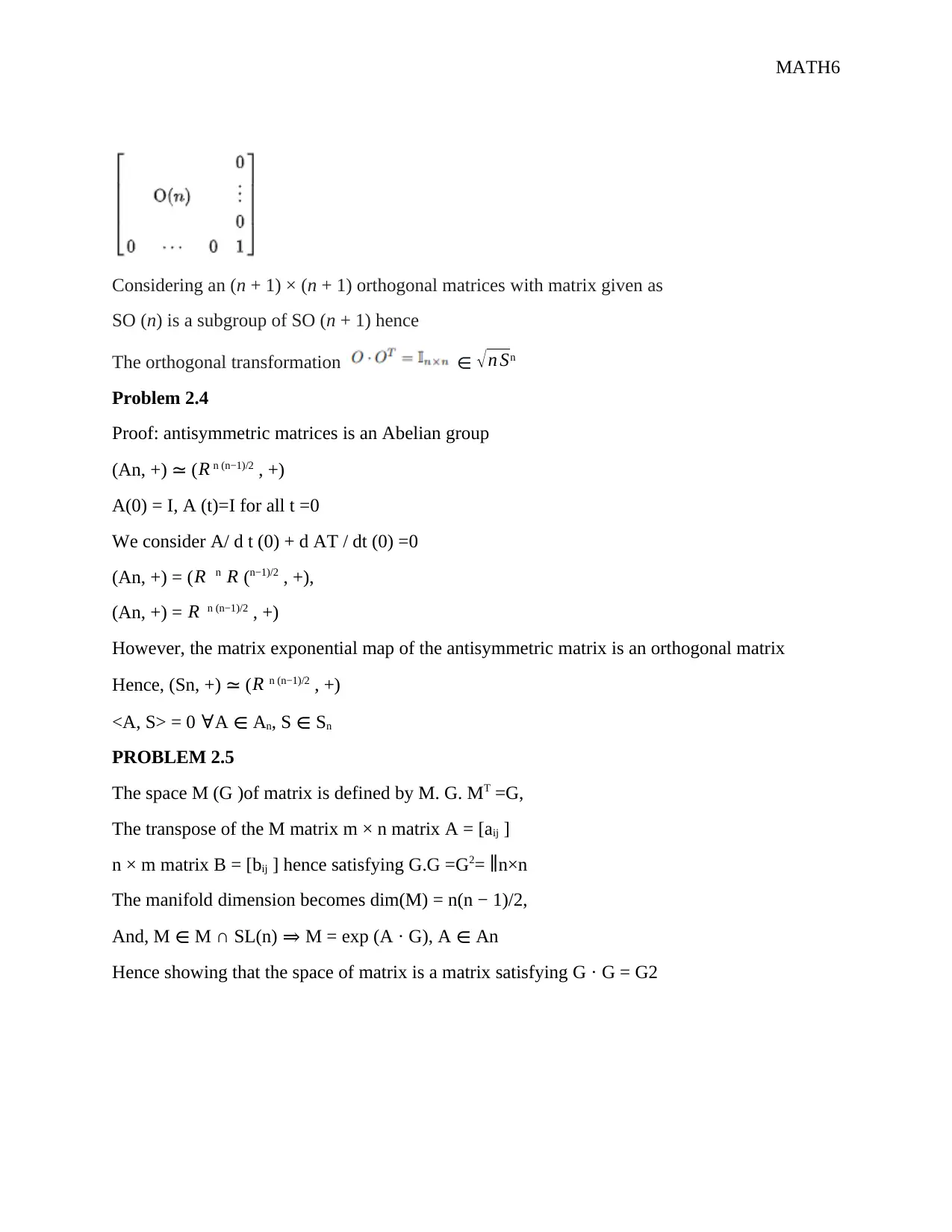
MATH6
Considering an (n + 1) × (n + 1) orthogonal matrices with matrix given as
SO (n) is a subgroup of SO (n + 1) hence
The orthogonal transformation ∈ √n Sn
Problem 2.4
Proof: antisymmetric matrices is an Abelian group
(An, +) ≃ ( R n (n−1)/2 , +)
A(0) = I, A (t)=I for all t =0
We consider A/ d t (0) + d AT / dt (0) =0
(An, +) = ( R n R (n−1)/2 , +),
(An, +) = R n (n−1)/2 , +)
However, the matrix exponential map of the antisymmetric matrix is an orthogonal matrix
Hence, (Sn, +) ≃ (R n (n−1)/2 , +)
<A, S> = 0 ∀A ∈ An, S ∈ Sn
PROBLEM 2.5
The space M (G )of matrix is defined by M. G. MT =G,
The transpose of the M matrix m × n matrix A = [aij ]
n × m matrix B = [bij ] hence satisfying G.G =G2= ∥n×n
The manifold dimension becomes dim(M) = n(n − 1)/2,
And, M ∈ M ∩ SL(n) ⇒ M = exp (A · G), A ∈ An
Hence showing that the space of matrix is a matrix satisfying G · G = G2
Considering an (n + 1) × (n + 1) orthogonal matrices with matrix given as
SO (n) is a subgroup of SO (n + 1) hence
The orthogonal transformation ∈ √n Sn
Problem 2.4
Proof: antisymmetric matrices is an Abelian group
(An, +) ≃ ( R n (n−1)/2 , +)
A(0) = I, A (t)=I for all t =0
We consider A/ d t (0) + d AT / dt (0) =0
(An, +) = ( R n R (n−1)/2 , +),
(An, +) = R n (n−1)/2 , +)
However, the matrix exponential map of the antisymmetric matrix is an orthogonal matrix
Hence, (Sn, +) ≃ (R n (n−1)/2 , +)
<A, S> = 0 ∀A ∈ An, S ∈ Sn
PROBLEM 2.5
The space M (G )of matrix is defined by M. G. MT =G,
The transpose of the M matrix m × n matrix A = [aij ]
n × m matrix B = [bij ] hence satisfying G.G =G2= ∥n×n
The manifold dimension becomes dim(M) = n(n − 1)/2,
And, M ∈ M ∩ SL(n) ⇒ M = exp (A · G), A ∈ An
Hence showing that the space of matrix is a matrix satisfying G · G = G2
⊘ This is a preview!⊘
Do you want full access?
Subscribe today to unlock all pages.

Trusted by 1+ million students worldwide
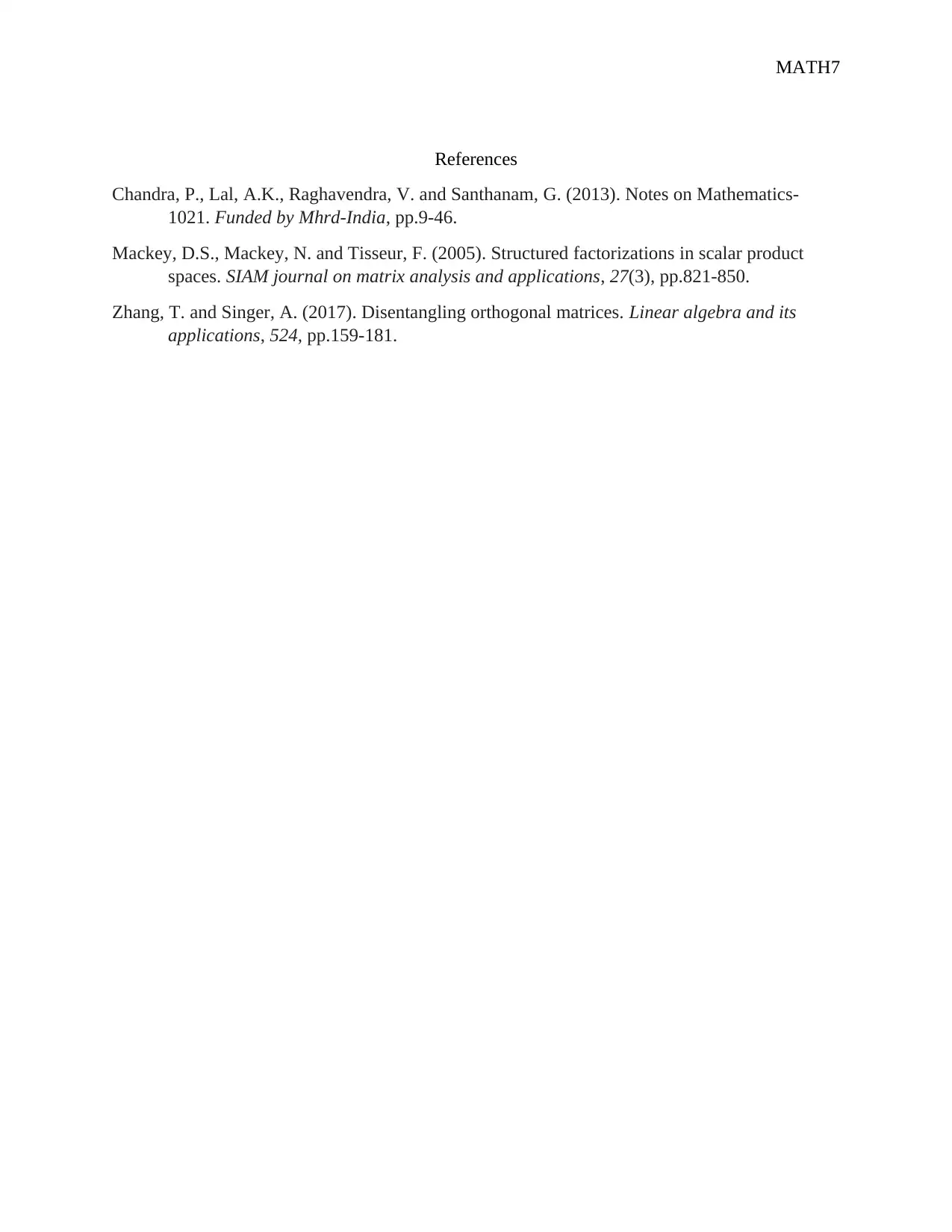
MATH7
References
Chandra, P., Lal, A.K., Raghavendra, V. and Santhanam, G. (2013). Notes on Mathematics-
1021. Funded by Mhrd-India, pp.9-46.
Mackey, D.S., Mackey, N. and Tisseur, F. (2005). Structured factorizations in scalar product
spaces. SIAM journal on matrix analysis and applications, 27(3), pp.821-850.
Zhang, T. and Singer, A. (2017). Disentangling orthogonal matrices. Linear algebra and its
applications, 524, pp.159-181.
References
Chandra, P., Lal, A.K., Raghavendra, V. and Santhanam, G. (2013). Notes on Mathematics-
1021. Funded by Mhrd-India, pp.9-46.
Mackey, D.S., Mackey, N. and Tisseur, F. (2005). Structured factorizations in scalar product
spaces. SIAM journal on matrix analysis and applications, 27(3), pp.821-850.
Zhang, T. and Singer, A. (2017). Disentangling orthogonal matrices. Linear algebra and its
applications, 524, pp.159-181.
1 out of 7
Related Documents
Your All-in-One AI-Powered Toolkit for Academic Success.
+13062052269
info@desklib.com
Available 24*7 on WhatsApp / Email
![[object Object]](/_next/static/media/star-bottom.7253800d.svg)
Unlock your academic potential
Copyright © 2020–2025 A2Z Services. All Rights Reserved. Developed and managed by ZUCOL.




